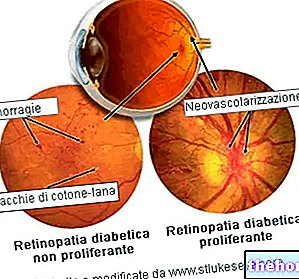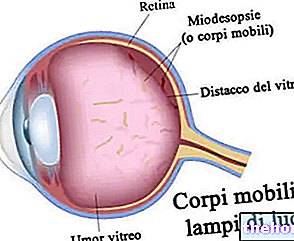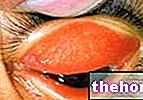Generality
Pterygium is a disease affecting the anterior surface of the eye. This pathological condition is characterized by the development of a fibrovascular membrane at the level of the scleral conjunctiva.

The causes that induce the development of pterygium are not yet fully known. The disease is probably favored by sun exposure and chronic irritation of the ocular surface.
Often, the pterygium is noticeable to the naked eye, but the doctor confirms the diagnosis with a careful examination of the affected structures.
The pterygium can be removed surgically, but this pathology tends to recur frequently.
What's this
A pterygium is a localized ocular surface disorder characterized by abnormal growth of bulbar conjunctival tissue.
The protuberance that is created has a horizontal pattern and, after a certain period of growth, tends to invade the cornea on the side of the eye closest to the nose. In some cases, this membrane can also be found on the temporal side of the same eye. The affected portion of cornea will become whitish and rich in vessels, with an irregular surface.
In practice, the pterygium resembles a kind of thin cloth or film that grows over the eye.
The term pterygium derives from the Greek "pterugion ", that is "small wing of" insect ", in reference to the aspect with which the disease presents itself.
Pterygium can cause astigmatism that is difficult to correct with glasses, due to the traction exerted by the conjunctiva.

Causes
A pterygium is a benign (non-cancerous) formation that usually occurs in adult patients; On the other hand, cases in children are very rare. The highest incidence occurs between 20 and 50 years of age and in males there is a double prevalence compared to females.
The causes that induce this change in normal conjunctival tissue are not yet fully understood. However, it is known that prolonged exposure to atmospheric agents, particularly wind and ultraviolet and infrared rays from sunlight, contributes to the onset of the disease.
For this characteristic, the pterygium is found above all in fishermen, mountaineers and other people who spend a lot of time in the sun or work outdoors, without the adequate protection of glasses or hats.
The disease also appears to be favored by chronic irritation of the ocular surface.
Other significant risk factors are represented by:
- Asian, African and South American population;
- Spend the first 5 years of life in equatorial geographic areas (note: pterygium is more common in warm climates; in fact, it is frequently found in tropical or subtropical countries).
Pterygium can develop from a pinguecula. This last lesion grows in relief near the cornea, but does not normally involve it (precisely for this aspect, it is distinguished from the pterygium).
Symptoms and complications
Pterygium develops slowly and progressively on the white part of the eye (sclera), in the nasal and temporal portions of the corneal periphery. This lesion may not be associated with specific symptoms.
In some patients, the pterygium can become red and inflamed in particular irritating circumstances, such as smoke-filled rooms, air conditioning, lack of sleep, and sunlight.
In case of inflammation, the following frequently occur:
- Persistent redness;
- Burning and discomfort in night vision;
- Excessive tearing
- Diplopia in lateral gaze;
- Sensation of having a foreign body in the eye.
If it grows excessively and significantly infiltrates the corneal stroma, the pterygium can interfere with vision by pulling and deforming (astigmatism) the cornea.
In more advanced cases, when the pterygium extends into the optic zone, there is a noticeable reduction in vision; in this case, the central portion of the cornea placed in front of the pupil is covered.
In an extremely small number of patients, pterygium can prevent the eye from moving completely in all directions.
Diagnosis
An eye examination is often sufficient to diagnose a pterygium, which is characteristic in appearance and location. The specialist physician can examine the cornea, iris and involved ocular adnexa with a slit lamp.
The pterygium may also be visible to the naked eye, as well as with the slit lamp, due to the presence of conjunctival tissue on the ocular surface. This formation typically looks like a triangle, with the apex facing the center of the cornea.
Therapy
The therapy is surgical and involves the "removal of the pterygium. This" intervention is performed on an outpatient basis, with local anesthesia, ie with the infiltration of the drug into the conjunctiva alone or a peribulbar injection.
Surgery is especially indicated in the following cases:
- Uncorrectable astigmatism;
- Occlusion of the optic zone;
- Recurrent inflammations that cannot be controlled with local therapy;
- Aesthetic reasons.
After the operation, at the point from where the pterygium has been removed, it may be necessary to take a flap of healthy conjunctiva from the same eye or from the other eye and transplant it (conjunctiva autotransplant). To complete the operation, it may be necessary to apply sutures or use a special biological glue (fibrin glue). Typically, recovery takes several weeks and involves the application of eye drops or topical ointments prescribed several times a day .
The removal of the pterygium is often repeated, as the lesion can re-form and cannot be controlled with ocular lubricants, nor with local anti-inflammatories.
Other ways of treating pterygium are not available, just as there are no medicines capable of preventing its growth.
The best way to avoid recurrence of the injury after treatment is to limit exposure to environmental factors that contribute to development (such as direct exposure to sunlight, irritants and dusty environments).
Prognosis
The removal of the pterygium cannot be considered definitive; this pathology can relapse, in fact, with a certain frequency.
This occurrence is more likely in the following situations:
- Previous eye interventions;
- Double pterygiums (nasal and temporal in the same eye);
- Fleshy pterygiums (which do not allow visualization of the underlying sclera).
In any case, failure to treat can cause irregular astigmatism that is difficult to correct with glasses.
Prevention of pterygium is essential for those exposed to ultraviolet rays. The use of sunglasses in accordance with the law, in fact, in addition to preventing their appearance, also protects the ocular structures from the potential damage of UV radiation (in particular, the retina and the lens).




























